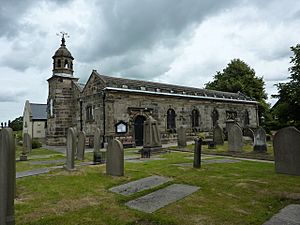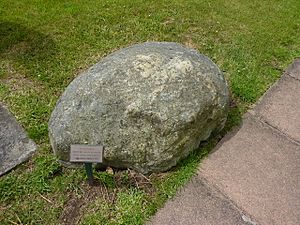St Anne's Church, Woodplumpton facts for kids
Quick facts for kids St Anne's, Woodplumpton |
|
|---|---|
 |
|
| Lua error in Module:Location_map at line 420: attempt to index field 'wikibase' (a nil value). | |
| OS grid reference | SD 49934 34445 |
| Location | Woodplumpton, Lancashire |
| Country | England |
| Denomination | Anglican |
| History | |
| Status | Parish church |
| Architecture | |
| Functional status | Active |
| Heritage designation | Grade II* |
| Designated | 11 November 1966 |
| Architect(s) | Austin and Paley (additions and restoration 1899–1900) |
| Administration | |
| Deanery | Garstang |
| Archdeaconry | Lancaster |
| Diocese | Blackburn |
| Province | York |
St Anne's is a historic church located in the village of Woodplumpton in Lancashire, England. It's an active Anglican church, meaning it's part of the Church of England. It serves as a parish church, which is the main church for a local area. St Anne's is considered a very important building, listed as Grade II* on the National Heritage List for England. This means it's a special building with a lot of history. The churchyard is also famous for being the rumored burial spot of a 17th-century woman named Meg Shelton, who was thought by some to be a witch.
Contents
History of St Anne's Church
Woodplumpton was once part of a larger church area called the ancient parish of St Michael's on Wyre. People believe there was a small chapel in Woodplumpton even before the year 1200. Records show this chapel existed by 1552.
The church building you see today was mostly rebuilt in 1630. Later, in 1748, a new section called the south aisle was added. Between 1899 and 1900, a famous architectural firm from Lancaster, Austin and Paley, worked on the church. They added new parts and fixed up old ones. This included putting in new windows, fixing the roof of the north aisle, repairing the archways, and making the vestry (a room for clergy) bigger. All these repairs cost about £2600.
In 1966, St Anne's Church was officially named a Grade II* listed building. This special title means it's a "particularly important building of more than special interest."
Church Architecture and Design
Outside the Church
St Anne's Church stands on high ground in the southern part of Woodplumpton village. It is built from different types of stone, including red and yellow sandstone and gritstone. The roofs are made of slate and stone slate.
The church has a main area called the nave, with long sections on either side called north and south aisles. It also has a chancel (the area near the altar), a tall tower at the west end, and a vestry on the north-east side. The nave and aisles each have their own pointed roofs.
The tower has a round-headed window and a square clock face on its south side. At the very top, there's an eight-sided structure called a cupola with rounded arches. On top of the cupola is a small stone dome and a weathervane that shows wind direction.
Inside the Church
Inside St Anne's, the nave and the chancel are not separated by a wall. The chancel, which is about one and a half sections long, is marked off by wooden screens.
The north side of the church has five archways. These arches are pointed and have sloped edges, resting on eight-sided pillars with decorative tops and bases. Both the north and south archways are built in a style called Perpendicular Gothic, which was popular in England. The south aisle is about 13 feet wide and built in a Classical style. It has flat columns (called pilasters), a decorative band (an entablature), and a molded edge (a cornice). This section also has a crenellated parapet, which looks like the top of a castle wall.
The church has two bells. One bell dates back to 1596, and the other was made in 1837.
The Churchyard and Its Stories
The churchyard at St Anne's is mostly located to the south and west of the church building.
Historic Features
Near the lychgate (a covered gateway to the churchyard), you can find old stocks. These were used in the past to hold people as a form of punishment. They are from the 18th century or even earlier and have been repaired. They have two stone posts, and one is carved with the initials "AB." These stocks are also a Grade II listed item.
South of the church, there is a sundial. The sundial sits on an eight-sided stone post and is dated 1657. The part that tells time and the pointer are made of brass. This sundial is also a Grade II listed item.
Other old features in the churchyard include a gateway from the 18th century and a mounting block, which was used to help people get onto horses. Both are also Grade II listed.
The Legend of Meg Shelton
The churchyard of Woodplumpton is famous for being the rumored burial place of a local 17th-century woman named Meg Shelton. She was known as the "Singleton witch" or the "Fylde Hag." According to a local legend, she was buried upside down to stop her from escaping her grave. A large boulder marks the spot where she is supposedly buried.
War Graves
The churchyard also contains the war graves of four British soldiers and one Canadian soldier who died in World War I. There is also the grave of a Royal Naval Volunteer Reserve officer who died in World War II.
See also
- Grade II* listed buildings in Lancashire
- Listed buildings in Woodplumpton


